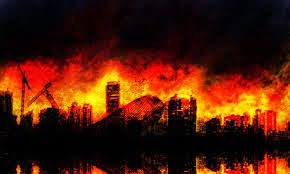Let's appreciate some more of the visual content of Poul Anderson's "The Star Plunderer."
When the human slaves are being taken from Earth:
"They herded us aboard a tender after dark. It was like a scene from some ancient hell - night overhead and around, lit by many score of burning houses like uneasy torches out there in the dark, and the long, weary line of humans stumbling toward the tender with kicks and blows from the guards to hurry them along."
-Poul Anderson, Rise Of The Terran Empire (New York, 2011), p. 330.
When the freed slaves in their captured spaceship attack Gorzun:
"Flame and ruin exploded beneath us. Spaceships burst open and toppled to crush buildings under their huge mass. Stone and metal fused, ran in lava between crumbling walls. The ground opened and swallowed half the town. A blue-white hell of atomic fire winked through the sudden roil of smoke. And the city died." (p. 359)
And when they return to Earth:
"It was winter in Earth's northern hemisphere when the Revenge came home. I walked out into snow that crunched under my feet and watched my breath smoking white against the clear pale blue of the sky. A few others had come out with me. They fell on their knees and kissed it. They were a wild-looking gang, clad in whatever tatters of garment they could find, the men bearded and long-haired, but they were the finest, deadliest fighting crew in the Galaxy now. They stood there looking at the gentle sweep of hills, at blue sky and ice-flashing trees and a single crow hovering far overhead, and tears froze in their beards.
"Home." (p. 360)
Imagine these scenes on a cinema screen or on a double page spread when you turn the page in a graphic novel. But I would want either kind of adaptation to reproduce the narrative and the individual scenes accurately. Manuel should be shorter than Reeves and Kathryn because that is how he is described. The tall gray four-armed Gorzuni, of course, present no problem for CGI. We have seen ERB's Tharks reproduced accurately in an otherwise inauthentic film.
A graphic adaptation can include visual details that are harder to spot in a film. For example, by looking back and forth between the first and third scenes presented here, we should be able to recognize some of the weary prisoners being herded towards the tender in the first scene as they later appear, wild, tattered, bearded and long-haired, in the third scene.
Without contradicting a prose text, visual adaptations can add details that we recognize as appropriate. The obsequious Mr Collins looks apologetic, not indignant, when he is rudely interrupted by his patroness, Lady Catherine de Bourgh, in a TV adaptation of Pride And Prejudice.
Is anyone planning to film Poul Anderson's works?

No comments:
Post a Comment